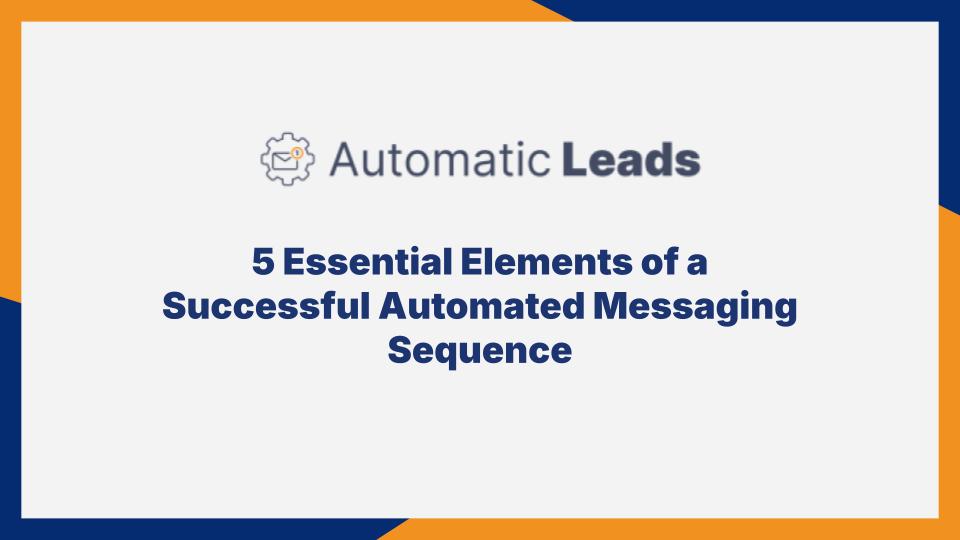An automated messaging sequence is a powerful tool for nurturing leads, guiding prospects through the sales funnel, and ultimately driving conversions.
When executed effectively, automated sequences allow you to engage with potential customers at scale, delivering relevant and timely messages that build trust and move them closer to making a purchase.
However, not all automated sequences are created equal.
To maximise their impact, it’s crucial to include these five essential elements in your messaging strategy.
1. Personalisation
Personalisation is key to building rapport and making your messages feel relevant. Even though the sequence is automated, prospects should feel as if the message was crafted specifically for them. Include personal details such as their name, company, or industry. Mentioning recent achievements or challenges relevant to their sector can also make the message feel more tailored.
For example, rather than sending a generic greeting, start with something like, “Hi [First Name], I noticed that [Company Name] is expanding into [New Market] — congratulations!” This level of personalisation helps establish an immediate connection and demonstrates that you’ve done your research.
2. Clear Call-to-Action (CTA)
Every message in your sequence should have a clear and compelling call-to-action (CTA) that guides prospects towards the next step. Whether it’s downloading a resource, booking a consultation, or scheduling a demo, your CTA should be direct, specific, and easy to follow.
Avoid overwhelming prospects with too many options. Instead, focus on a single action per message. For example, a simple CTA like “Click here to schedule a 15-minute call” is much more effective than a laundry list of options. As your sequence progresses, your CTAs should also build in intensity, moving prospects closer to making a decision.
3. Timely Follow-Ups
Timing is everything in automated messaging. The frequency and timing of your follow-ups can significantly impact engagement rates. Too many messages in a short period can lead to frustration, while too few can result in lost interest.
A successful sequence often starts with a welcome message immediately after a prospect engages with your content or signs up. Subsequent messages should follow a logical cadence — for example, 1–2 days after the first message, then 3–5 days for the next. This allows you to stay on your prospect’s radar without overwhelming them.
Data-driven insights can help optimise timing based on open rates and engagement, ensuring your follow-ups reach prospects at the right moments.
4. Value-Driven Content
Every message in your sequence should provide value to the reader. Rather than focusing solely on selling, aim to educate, inform, or entertain. Share content that addresses common pain points, offers solutions, or highlights industry trends. By positioning your brand as a helpful resource, you can build credibility and trust with your audience.
For example, you might start with an educational article or a relevant case study, followed by a success story that demonstrates how your product or service can solve a specific problem. Value-driven content not only keeps prospects engaged but also positions your brand as a trusted advisor rather than a pushy salesperson.
5. Social Proof and Credibility
To build trust with prospects, include elements of social proof and credibility in your messaging sequence. Testimonials, case studies, and user reviews can all reinforce the value of your offering and make it more relatable. Prospects are more likely to trust a product or service that has proven results and positive feedback from other users, especially if those users are similar to them.
You might also include snippets of data or statistics that highlight your achievements or industry recognition. For instance, “Our clients typically see a 30% increase in leads within the first month” is a powerful statement that reinforces credibility and shows tangible benefits.
Bringing It All Together
A successful automated messaging sequence combines personalisation, clear CTAs, timely follow-ups, value-driven content, and social proof to create a cohesive and engaging experience for prospects.
By integrating these elements, you can build stronger connections with your audience, keep them engaged, and ultimately guide them towards a purchasing decision.
The key is to continuously monitor and refine your sequence based on performance data.
Open rates, click-through rates, and conversion rates can all provide insights into what’s working and what isn’t, allowing you to optimise and enhance your approach over time.
Automated messaging sequences, when done right, can be a powerful asset in your lead generation strategy.
With the right elements in place, you can deliver a personalised experience at scale, building trust and driving conversions with every message.

